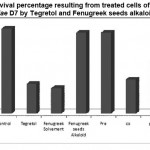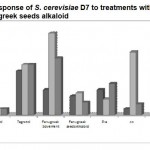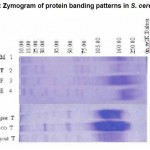How to Cite | Publication History | PlumX Article Matrix
Nada, H. A. Al-Twaty
Department of Biology, Faculty of Science, King Abdulaziz University, P .O. Box 42613- Jeddah 215 51 Saudi Arabia.
ABSTRACT: Protection by the fenugreek seeds alkaloid against mitotic crossing over, gene conversion and reverse mutation included by tegretol were investigated in Saccharomyces cerevisiae D7. Also estimate the alteration of protein banding after individual and combined treatments by using protein electrophoresis analysis. The single treatment of tegretol due significant reduction on survival percentage and induced mitotic crossing over , gene conversion and reverse mutation. The previous treatments with fenugreek with tegretol reduse all studied genetic mutation frequency than tegretol alone. All the combined treatments with fenugreek and tegretol did not affect in general on the density of protein bands , in comparison with tegretol separately.
KEYWORDS: Saccharomyces cerevisiae D7; Genotoxicity; Antimutagenicity; fenugreek seeds-tegretol
Download this article as:| Copy the following to cite this article: Nada, Al-Twaty H. A. Protection by the Fenugreek seeds alkaloid against mitotic crossing over, gene conversion and reverse mutation included by tegretol in Saccharomyces cerevisiae D7. Biosci Biotechnol Res Asia 2008;5(1) |
| Copy the following to cite this URL: Nada, Al-Twaty H. A. Protection by the Fenugreek seeds alkaloid against mitotic crossing over, gene conversion and reverse mutation included by tegretol in Saccharomyces cerevisiae D7. Biosci Biotechnol Res Asia 2008;5(1). Available from: https://www.biotech-asia.org/?p=6434 |
Introduction
Fenugreek is a leguminous plant. In botanical nomenclature it is called Trigonella foenum-graecum and its seeds are used as a traditional herb and spice in Asia and Europe¹. Fenugreek seeds also are used as a traditional remedy for treatment of diabetes and hypercholesterolemia Basch and coworkers² and Kaviarasan and coworkers³ studied the protective effect of polyphenolic extract of fenugreek seeds against ethanol-induced toxicity in humans. Ethanol-induced toxicity causes changes in the liver cells and the study proved that the polyphenolic compounds of fenugreek seeds was cytoprotective during the ethanol damage. Also, Kaviarasan et al.,4
reported that fenugreek seed polyphenols inhibited ethanol-induced collagen and lipid accumulation in the rat liver. In Saudi Arabia, fenugreek is among the most common herbs used by people with diabetes5. The seeds are rich in protein and contain a unique major free amino acid 4-hydroxy- isoleucine which has been characterized as one of the active ingredients in fenugreek seeds¹.
Tegretol is one of the most commonly used anti-covulsant drugs for treatment of epilepsy. It is also used in treatment of trigeminal neuralgia, psychiatric diseases6. The study showed that tegretol has a chromosome damaging effects as indicated by chromosome aberrations, sister chromatid exchanges and cell cycle analysis in the treatment of epileptic patients. More recently, it has been found that long-term therapy with a form of tegretol (carbamazepine) can lead to genotoxic effects presented by an increase in the sister chromatid exchanges and proliferation rate index; it has, however, no effect on other cytogentic parameters and micronuclei7. In addition, Celik8 studied the genotoxicity of tegretol using cytokinesis- block micronucleus assay and showed that tegretol caused a genotoxic effect under in vitro conditions and also cytotoxic effects of tegretol were revealed by a decrease in the cytokinesis-block proliferation index in human blood lymphocytes.
Xue et al.,9 furthermore, studied the effect of fenugreek extracts on blood glucose, blood lipid and haemorheological properties in streptozo-tocin-induced diabetic rats.
The study showed that fenugreek extract could lower kidney/body weight ratio, blood glucose, and blood lipid levels and improve haemorheological properties in diabetic rats. Furthermore, Hananan et al.,10 suggested that fenugreek seed also improves glucose homeostasis in animal models of type 1 and type 2 diabetes by delaying carbohydrate digestion and absorption in addition to enhancing insulin action. The present study was carried out to assess the genotoxecicity effects of tegretol on S.cerevisiae D7. The effect of tegretol on S.cerevisiae D7 was also assessed when it was combined with fenugreek seeds alkaloid.
Material and Methods
Yeast strain
The D7 strain of Saccharomyces cerevisiae was used as a test organism (Courtesyof F. K. Zimmermann. Darmsted. Germany).
This strain has the following genotype: ade2-40 / ade2-119, trp5-12 / trp5-27, ilvl-92 / ilvl-92.
The organism was employed for simultaneous detection of induced reverse mutation, mitotic gene conversion, and mitotic crossing-over¹¹.
Chemicals
Fenugreek seeds alkaloid obtained from Dr. Asmahan Ahmed Mahmoud.
Faculty of Sciences, Saudi Arabia.
Carbamazepine is one of the antiepileptic and CNS treatment drugs. It was obtained from (Novartis Pharma) in the form of tegretol
Media
Complete medium
This medium was used for routine growth culture, it contains : peptone 5 mg/L, yeast extract 10g/L, and Agar 20 g/L
Minimal medium
The media components have been described in detail by Zimmermann et al.¹¹.
Testing assay
Preparation
Fenugreek seeds alkaloid was dissolved in ethanol: 5g Fenugreek / 20ml ethanol / in one liter distilled water
Preparation
1800 mg tegretol (carbamazepine) was dissolved in one liter distilled water
Treatment protocol
10 ml of the complete medium was inoculated with about 5 x 10 cells/ml in a 50 ml conical flask.
The culture was incubated on an orbital shaker water bath at 24 °C for 6 hrs.
The sample of the cell was examined under the microscope, the proper culture must be in experimental phase (at least 90% of the cells have buds).
Concentration series for treatment were inoculated cached with 1 ml sample cells and incubated at 28 ºC on a water bath shaker for 18 hrs.
After appropriate dilution, the cells were plated onto:-
Complete media with cycloheximide to detect mitotic crossing over
Synthetic complete media without tryptophan to detect gene conversion
Synthetic complete media without isoleucine to detect point mutation
For revealing the induction of total protein variation will be prepared according to Studier¹².
Analysis and evaluation of data
The frequencies of gene conversion reverse mutation and mitotic crossing over were computed by dividing the number of convertant, revertant and mitotic crossing over colonies. The consensus was that the increase in an end point under investigation up to two folds or more of the mean of control frequency is biologically considered as a significant response¹³.
Results and Discussion
The result in table 1 and fig (1) show the survival percentage of S. cerevisiae D7 after treatments with tegertol, and fenugreek seeds alkaloid individually and in combination.
Table 1: Survival percentage resulting from treated cells of cerevisiae D7 by Tegretol and Fenugreek seeds alkaloid.
| Treatments | Number of cells Survival | percentage |
| Control | 12128 | 100.00% |
| Tegretol | 3720 | 30.70% |
| Fenugreek solvent | 3536 | 29.16% |
| Fenugreekseeds alkaloid | 11388 93.90% | |
| Tegretol and Pre | 11536 | 95.12% |
| Fenugreek seeds Co | 4426 | 36.40% |
| alkaloid Post | 6792 | 56.00% |
 |
Figure 1: Survival percentage resulting from treated cells ofcerevisiae D7 by Tegretol and Fenugreek seeds alkaloid.
|
Treatment with tegretol alone shows a significant reduction in the number of survived cells (30.70%). However, pre-treatments with fenugreek seeds alkaloid and tegretol shows a significant increase in survival rate (95.12%). The fenugreek co-tegretol treatment caused slight increase of survival rate (36.40%). Also, post-treatment with fenugreek and tegretol brought about an increase in survival rate (56%).
Survival rate increase in fenugreek pre-tegretol treatment proved to be more thantreatment with fenugreek in comparison with co, and post treatment with tegretol. This set of results is in agreement with the results obtained by Kunglos and Aoyama14 and Staleva et al.,15 using in S. cerevisiae. It is also in agreement with the results published by Burim, et al.,16 using human lymphocytes, Rowland17 using mammal cells and Arkhipchuk et al.,18using Allium cepa.
Table 2 and figure 2 show that the genetic activities in Saccharomyces Cerevisiae D7 after treatment with such tegretol and fenugreek seeds alkaloid. Positive mutagenic activity was observed using tegretol alone where the induced frequency of mitotic crossing over at the cycloheximide (Cyh) locus which was 6.2 times the spontaneous frequency, also, the induction of gene conversion at the tryptophan-5 (Trp-5) Locus was 7.2 and reversion at isoleucine (il) locus was 7.1 times the spontaneous frequency. Moreover, moderate mutagenic activity was shown at the two loci under study when fenugreek applied alone, which resulted in mitotic crossing over and reversion in frequency 2.6 and 3.2 times the spontaneous ones, respectively. On the other hand, negative results in the induction of gene conversion of the tryptophan-5 lcous was observed. These results suggest that the mutagenic effect of tegretol in the induction of convertant, revertant and mitotic crossing over in Saccharomyces cerevisiae D7. This is in agreement with the results obtained by many studies those of using tegretol in S. cerevisiae 15,19-21. Our results were also in agreement with Sinues, et al.,7 and Awara, et al.,6 in human after treatment with tegretol.
In addition the frequencies of convertant and mitotic crossing over in the combined treatment with fenugreek co-tegretol does not present statistical significance in the frequencies of spontaneous (Table 2 and fig 2). However, moderate mutagenic activity was obtained at the three loci under study when fenugreek pre tegretol in the combined treatment which resulted in gene conversion, reversion and mitotic crossing over with frequency, 4.8 , 2.3 and 3.9 times the spontaneous ones, respectively. On the other hand, the frequencies of convertant in the combined treatment with fenugreek posttegretol was 9.3 times compared to the control levels. However, weak positive mutagenic activity was observed using fenugreek post-tegretol, where the induced frequency of revertant and mitotic crossing over was 5 and 5.4 times the spontaneous ones, respectively.
Table 2: Response of S. cerevisiae D7 to treatments with Tegretol and Fenugreek seeds alkaloid.
| Convertant Revertant Mitotic crossing over |
| Treatment Number Survival Mut Freq T/C D.of Mut T/C D.of Mut T/C D.of |
| of cell percentage Act Freq Act Freq |
| Control 10992 100.00% (210)191,05 1,00 – (170)154,6 1,00 – (328)298,3 1,00 – |
| Tegretol 4728 43.0% (650)1374,8 7,20 + (530)1121 7,10 + (882)1865.4 6,20 + |
| Fenugreek 4476 40.7% (824) 1841 9,60 + (937)2093,4 13,50 ++ (518)1157,2 3,90 + |
| solvent |
| Fenugreek seeds 15352 94.2% (538) 350,4 1,80 – (777) 506,1 3,20 + (1200) 781,7 2,60 + |
| alkaloid |
| Tegretol & Pre 10100 91.9% (924) 914,8 4,80 + (368) 364,3 2,30 + (1169)1157,2 3,90 + |
| fenugreek Co 8852 80.5% (242) 273,4 1,40 – (1352)1527,3 9,90 + (162) 183 61 – |
| seeds Post 5036 45.8% (896)1779,2 9,30 + (388)770,4 5,00 + (826)1640,1 5.40 + |
| alkaloid |
| C = Control level T = Treatment value |
| + = 2-10 control level ++ = > 10 control level – = non significant |
| D. of Act. = Degree of activity, numbers between parentheses represents actual colony counts |
T=Tegretol F=Fenugreek E=Ethanol M=Marker
 |
Figure 2: Response of S. cerevisiae D7 to treatments with Tegretol and Fenugreek seeds alkaloid.
|
The results of the present study show that fenugreek seeds alkaloid may prevent binding of metabolically activated of tegretol with DNA and inhibit its mutagenicity. Also, the organism defence system may protect the organism from exogenous and endogenous DNA defeating factors. Synergism has been proposed as the main principle of defense system organization²². Our results are in agreement with the results obtained by other researchers using fenugreek in antimutagenicity tests1,2,5.
Fig 3, reveals that previous or concurrent treatment with tegretol causes various changes in protein production patterns. In other words, the protein pattern in the organism shows appearance of new protein bands and disappearance of another.
 |
Figure 3: Zymogram of protein banding patterns in S. cerevisiae.
|
Also, Tegretol treatment was accompanied by changing of band intensity. Combined treatments with fenugreek and tegretol did not affect the intensity of protein bands, only the combined treatment led to a small increase in the sub-bands of protein.
In conclusion these results suggest that tegretol has a mutagenic effect on is used in the treatment of Saccharomyces cerevisia D7 as indicated by mitotic crossing over, gene conversion and reverse mutation. The results also demonstrated a protective effect (antimutagenic activity) of fenugreek seeds alkaloid against tegretol induced mitotic crossing over, gene conversion and reverse mutation. The latter needs further investigations and it is currently in progress in our laboratory.
References
- Flammang, A.M., Cifone, M.A., Erexson, G.L. and Stan kowski, L.F., Genotoxicity testing of a fenugreek extract. Food and Chemical Toxicology, 42: 1769-1775 (2004).
- Basch, E., Ulbricht, C., Kuo, G., Szapary, p., Smith, M., Therapeutic applications of fenugreek. Alternative Med. Res., 8(1): 20-27 (2003).
- Kaviarasan S, Ramamurty N, Gunasekaran P, Varalakshmi E, Anuradha CV., Fenugreek (Trigonella foenum graecum) seed extract prevents ethanol- induced toxicity and apoptosis in Chang liver cells, Alcohol Alcohol. 41(3): 267-73 (2006).
- Kaviarasan S, Viswanathan P, Anuradha CV., Fenugreek seed (Trigonella foenum graecum) polyphenols inhibit ethanol-induced collagen and lipid accumulation in rat liver. Cell Biol Toxicol. Apr 24; [Epub ahead of print] (2007).
- AL-Rowais, N.A., Herbal medicin in the treatment of diabetes mellitus. Saudi Med. J. 24 (11): 1327-1331 (2002).
- Awara, W.M., EL- Nabi, S.H. and Fadel, W.A., In vivo and in vitro evaluation of the mutagenic potential of carbamazepine : Does melatonin have anti-mutagenic activity?. Toxicology., 125: 45-52 (1998).
- Sinues, B., Gazulla, J., Bernal, M.L., Lanuza, J., Fanlo, A., Sacnz, M.A., and Rarolome, M., Six mutagenicity assays in exposure biomonitoring of patients recevinig carbamepine for epilepsy or trigeminal neuralagia. Mutat. Res., 334: 254-265 (1995).
- Celik A., The assessment of genotoxicity of carbamazepine using cytokinesis-block (CB) micronucleus assay in cultured human blood lymphocytes. Drug Chem Toxicol. 29(2):
227-36 (2006). - Xue WL, Li XS, Zhang J, Liu YH, Wang ZL, Zhang RJ. Effect of Trigonella foenumgraecum (fenugreek) extract on blood glucose, blood lipid and hemorheological properties in streptozotocin-induced diabetic Asia Pac. J Clin Nutr.,16(S1): 422-426 (2007).
- Hannan JM, Ali L, Rokeya B, Khaleque J, Akhter M, Flatt PR, Abdel Wahab YH., Soluble dietary fibre fraction of Trigonella foenum-graecum (fenugreek) seed improves glucose homeostasis in animal models of type 1 and type 2 diabetes by delaying carbohydrate digestion and absorption, and enhancing insulin action. Br J Nutr. Mar; 97(3): 514-21 (2007).
- Zimmermann, F. K.; Kern, R., and Resenberger, H., A yeast strain for simulataneous detiction of induced mitotic crossing over, mitotic gene conversion and reverse mutation. Mutat Res., 28: 381-388 (1975).
- Studier, F.W., Analysis of bacteriophage T7 early RNAs and proteins on slab. J. Mol. Biol, 79: 237-248 (1973).
- Brusick, D., Principles of Genetic Toxicology. Plenum press, New York, p. 2790 (1980).
- Kungolos, A. and Aoyama, J., Using Saccharromyces cerevisiae for toxicity assessment including interacting effects and DNA damage. Watet Sci Technol., 25(11): 309-316 (1991).
- Staleva L, Hall A, Orlow SJ., Oxidative stress activates FUS1 and RLM1 transcription in the yeast Saccharomyces cerevisiae in an oxidant-dependent Manner. Mol Biol Cell. Dec; 15(12): 5574-82 (2004).
- Burim, R.V., Canalle, R.,Lopes, J.L.C. and Takahashi, C.S., Genotoxic action of the sesquiterpene lactone glaucolide Bon mammalian cells in vitro and in vivo. Genetic and Molecular Biology, 22(3): 401- 406 (1999).
- Rowland, L.P., “Current neurologic drugs” 3rd ed. Awolters kluwer company. Philadelphia, Baltimore, New York, London, Hong Kong, Tokyo, 149-156 (2000).
- Arkhipchuk, V.V., Goncharuk, V.V., Charnykh, V.P., Malshtan, J.N. and Gristenkc, I.S., Use of a complex approach for assessment of metamizole soudium and acetyl-salicylic acid toxicity, genotoxicity and cytotoxicity. J.Appl. Toxicol., 24(5): 401-407 (2004).
- Angela, S.Z. and Rodolf., Montring of induced chromosomal aberrations in S.cerevisiaein agarose gels by pulsed field gel electrophoresis., Mutat Res., 334: 285-292 (1995).
- Miadokova, E., Vichova, V., Duhova, V., Trebaticka, M., Grolmus, J., Bohmoua, B., podstavakova, S., Rauko, P., Plesnikava and Vleek, D., The comparative genotoxicological study of new Local anesthetics, 3-C2-alkoxyphenyl carbamoy-Loxy) quinuclidium chlorides on Salmonella typhimurium , Saccharromyces cerevisiae , Vicia fabe, Hordeum vulgare and Drosophila melanogaster, Mutat Res., 12(3): 135-145 (1996).
- Wittschiebemi, J.P., Reshmi, S.C., Golin, S.M., and Wood, R.D. Loss of DNA polymerase zeta causes chromosomal instability in mammalian cell. Cancer Res., 1., 66(1): 134-142 (2006).
- Ahmed, E.S., protection the flavonids rutin and proto chatechuic acid, against mitotic crossing over, gene conversion and reverse mutation induced by (chorpyrifos) in Saccharomyes cerevisiae D7. The Egyption. J. of Hospital Medicine., 23: 385-391
(2006).

This work is licensed under a Creative Commons Attribution 4.0 International License.





